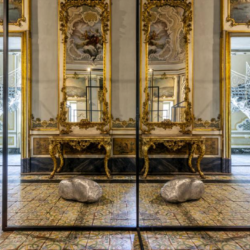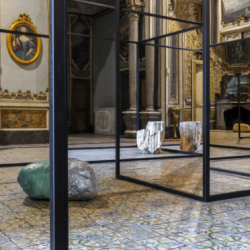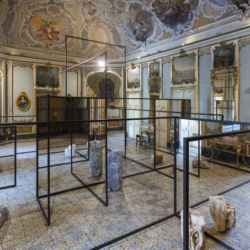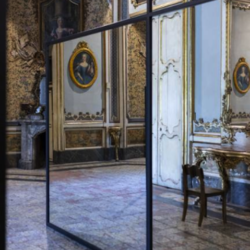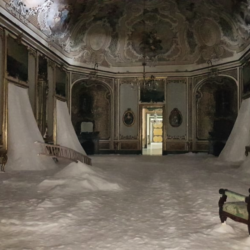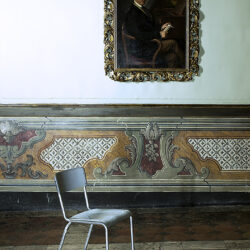
EXHIBITIONS
Palazzo Biscari has an old tradition linked to art and exhibitions. Already, in the eighteenth century it inaugurated an archeological, numismatic and naturel history museum. The collections belonged to Ignazio Paterno Castello, fifth Prince of Biscari, which were, until 1924, located in the Biscari museum.
Over the last two years the Palace has held innovative contemporary art exhibitions of internationally acclaimed artists, catalyzing the interest of local citizens, tourists and media.
From July 11 until August 31, 2021, Palazzo Biscari hosts MONDO: Museo Archeologico del Reale.
Curated by Pietro Scammacca and Claudio Gulli.
The exhibition project stems from a reflection on the museum as a historical device that invents “nature” and the multiplicity of the “real” through taxonomically organized knowledge.
This project arises from new research about the Museo Biscari, one of the first museums open to the public in Sicily, founded in Catania in 1758 by Ignazio Paternò Castello (1719–1786). Inaugurated a few decades after a devastating 1693 earthquake, it intended to “give back” a sense of identity and collective memory grounded in archeological findings. In 1934 the collection was given to the Civic Museum of Castello Ursino, where many of the objects remained in storage. For Mondo, after almost a century, some of those objects and artifacts have returned to the Baroque palace.
Leotta reconceptualizes this “lost museum” as a medium through which to rethink a museography derived from examinations of the natural landscape and its possible interpretations. Thus, the exhibition is a mise en scène of a new “Archaeological Museum of the Real,” where concepts of nature and culture are treated on a single epistemological level. Human-made artifacts testify their adherence to nature and time.
Taking its cue from an index hand written by the prince qua archaeologist, recently found in the palace’s archives, the exhibition opens with a section dedicated to the sky, presenting a cosmology of watercolor representations of heroes and divinities from the Greco-Roman world. This idealized listing of the museum’s statuary acts as the incipit and guide to the exhibition.
Departing from modern preconceptions that divide land, sea, and air, the next section presents Gipsoteca, a series of sand casts by Leotta produced by registering the motion of waves on beaches during low tide due to lunar cycles. Dedicated to the moon, this room is completed by a collection of photograms by the artist realized with the bioluminescence of plankton, as well as an archaic marble head inventoried in the original Biscari collection by the archaeologist Guido Libertini as “exhibit N.2,” thought for decades to be lost. In the artist’s research, it became known that the antique sculpture, representing a young man, was placed by the prince on a female bust in one of his experimental assemblages that he frequently conducted in the laboratories of the museum.
In the orchestra hall, ancient marbles, Attic and Sicilian vases, Roman-era bronzes, Mexican ceramics, and glass ampoules are displayed in a museography that echoes the earth’s movements and the temporalities of material culture. Additionally, a selection of stuffed birds from the Museum of Zoology of the University of Catania recalls the representations in the palace’s “Gallery of the Birds,” a room detailing the Prince’s amateur ornithological research through frescos. This room features Sicilian vases and terracotte from the prince’s archaeological excavations throughout Sicily, as well as an Egyptian headless bust in basalt that was used as a magical statuette to protect and heal. Lastly, this room also presents objects referencing to Mount Etna, the largest active volcano in Europe, through traces of recent eruptions and a collection of volcanic bombs from the Ecomuseo della Riviera dei Ciclopi. In this central gallery, this Archaeological Museum of the Real becomes apparent as cultural heritage and landscape merge together.
The exhibition is accompanied by “Mondo Meridiano,” a public program dedicated to the late professor Franco Cassano, and the first issue of Lachea with contributions by Christian Greco, Sofia Gotti, Claudio Gulli, Renato Leotta, Pietro Scammacca, Cristiano Raimondi, and Leonardo Caffo.
The project is supported by the Exhibit Program / Directorate-General for Contemporary Creativity of the Italian Ministry of Culture.
The exhibition has been realized thanks to loans from the Civic Museum Castello Ursino, the Museum of Zoology of the University of Catania, and the Ecomuseo della Riviera dei Ciclopi.
The project is presented by UNFOLD and ISTITUTO SICILIA.
Thanks to the sponsors Palazzo Biscari Srl, MAG Spa, Murgo Winery e Piante Faro.
Date: 11 luglio – 31 agosto 2021
Works from the Sandretto Re Rebaudengo Collection at Palazzo Biscari
From July 8, 2019 Palazzo Biscari hosts a selection of artworks from the prestigious Sandretto Re Rebaudengo Collection. The project, curated by Ludovico Pratesi and Pietro Scammacca, in collaboration with Fondazione Sandretto Re Rebaudengo and UNFOLD, is promoted by Fondazione Terzo Pilastro – Internazionale, chaired by Professor Emmanuele F. M. Emanuele and realised in collaboration with Poema S.p.A., along with the support of Fondazione Sicilia and Dusty Srl.
The works from the Sandretto Re Rebaudengo Collection occupy two parts of the palace: an environmental installation by the artist Alicja Kwade in the Ballroom (open until August 24, 2019), and a group exhibition titled “The analogous room” in the Eastern wing apartments, open to the public for the first time (until September 7, 2019).
WeltenLinie (2017) by Alicja Kwade is a composition made of mirrors and steel frames, produced by the Sandretto Re Rebaudengo Foundation on the occasion of the 57th Venice Biennale. The work animates an environment constructed from ambiguous reflections in which objects multiply and appear to be set in motion, in the process seemingly transforming space into temporal matter. Its presentation in the alchemical space of Palazzo Biscari’s Ballroom establishes an evocative dialogue with the ornamental interiors of the palace, and resonates with the illuminist and esoteric visions of its most illustrious inhabitant: Ignazio Paternò Castello, V Prince of Biscari.
A polyhedral figure, responsible for numerous archeological findings in Sicily, Paternò Castello also created a vegetal labyrinth which acted as thse public garden of the city of Catania until the mid-nineteenth century. In this context, Kwade’s environment becomes a sort of “baroque machine” that reconfigures the viewer’s relationship with reality.
In dialogue with the mirrors of the Ballroom and the many trompe l’oeil that decorate the walls, Kwade’s installation plunges the visitor into a kaleidoscopic and labyrinthine space of perception.
The Eastern Wing apartments host the group show “The analogous room,” which acts as an echo of a particular space in Palazzo Biscari: a room named after Don Quixote and decorated with twelve paintings depicting scenes from the journeys of Cervantes’ picaresque character. The exhibition brings together twenty artists from the Collection from different generations that have carried out a critique of representation in different languages and mediums. Similar to narrative devices found in Cervantes’ novel—such as the destabilization of authorship and authenticity, which anticipate strategies in art of the late twentieth-century—the works explore different structures of meaning and signification, questioning the legitimacy of knowledge and truth. Like Don Quixote, the artists move along a thin line that separates reality from fiction: ‘alienated in analogy’, they become ‘the disordered players of the Same and the Other’, to quote observations by Michel Foucault. The “Don Quixote room” is inaccessible to visitors, but is alluded to by the arrangement of work to become present in their imaginations, thus acting as a starting point for the exhibition. This creates an analogy between the physical but unseen space of the eighteenth-century room, and the conceptual but perceptible space of the exhibition.
In hosting a private collection, the palace seeks to create connections with its prior role as a museum of archaeological findings, scientific instruments, and natural rarities belonging to the collection of Ignazio Paternò Castello, V Prince of Biscari, which occupied the rooms of the Biscari Museum until the last century.
The exhibition is accompanied by a didactic program organized by the educational department of the Sandretto Re Rebaudengo Foundation which has trained a group of students from the University of Catania to become cultural mediators of the exhibition.
We thank Palazzo Biscari, Dusty, Ciaccioarte | Insurance Services, Murgo Winery, Fondazione OELLE, and Radice Pura for their generous support.
My heart is a void. The void is a mirror. by Gian Maria Tosatti
For the first time in its history, Palazzo Biscari, one of the most magnificent Baroque palaces in Sicily, opens its doors to a contemporary artist. From the 16th of July to the 18th of August 2018, the palace hosted a site specific environmental installation by Gian Maria Tosatti entitled Il mio cuore è vuoto come uno specchio – episodio di Catania (My heart is a void. The void is a mirror – episode of Catania), curated by Adele Ghirri, Ludovico Pratesi, and Pietro Scammacca. The exhibition is a collateral event of Manifesta 12 Biennale and has been supported by Virlinzi S.P.A. and Murgo Winery.
Il mio cuore è vuoto come uno specchio – episodio di Catania marks the first chapter of a pilgrimage that will take the artist across Europe in search of Modernity’s ruinous remains, which project their shadow onto the present, and the gems of a new time—perhaps a ‘New History.’ Tosatti positions himself as a testimony to one of the most profound historical passages that the West has ever registered, a moment stretched between a future in total transformation—professed by authors such as Pier Paolo Pasolini—and the oppositionality of old structures, such as the nation-state, capitalism, and colonialism, which in reactionary revolt reveal their most sinister faces. The work, which takes its shape from the eighteenth-century palace, is thus a sort of prologue, a visionary and cruel space that will occupy the central stairway, the first three chambers of the salons, and the monumental ballroom. Tosatti’s work presents itself as a journey that the visitor will venture individually: a solitary path as a visual novel that begins from the very first step of the central stairway.
Through a narrative structured by the architecture of the edifice, but rich with references to Visconti, Céline and his personal diaries, the artist orchestrates an immersive experience and transforms the palace into a contemporary ruin deprived of its genius loci. With the creation of this spectral atmosphere, halfway between presence and absence, past and future, Tosatti generates a temporal paradox that situates the visitor in what could be defined as the afterlife of modernity, a point of passage between two radically different epochs.
The contrast that takes shape between these themes and the baroque frescoes gracing the palace’s walls recalls the notion of allegory as conceptualized by Walter Benjamin in The Origin of German Tragic Drama (1925). For Benjamin, the baroque allegory is a form of expression that manifests itself in the eschatological passages of History, when the decline and precariousness of a civilization become perceptible. My heart is a void. The void is a Mirror – Episode of Catania – which borrows its title from Ingmar Bergman’s The Seventh Seal, is an allegorical and entropic space, where time seems to be finished, or to continue in a separate direction.
The artist
The practice of Gian Maria Tosatti (Rome, 1980) is constituted by large-scale cycles of works, which are meant to investigate specific subjects related to the concept of identity, from political to spiritual standpoints. The long-term projects realised so far have been usually developed in historical edifices, monumental buildings that Tosatti transformed into “potent visual machines,” unveiling topics that resonate with the present time and in deep relation with the communities involved. Sometimes, these operations have transformed urban landscapes (Sette Stagioni dello Spirito, Naples 2013 – 2016) or even geographical zones (New Men’s Land, Nord-pas-de-Calais 2015-2016). Each project is shaped and organised as a “visual novel”, often divided in chapters, delineating an experiential pathway for the audience which challenges the limits of the relationship between art and reality.
Tosatti has won several awards (such as the Talent Prize, the Terna Prize, and the Premio New York) and in 2015 he was listed in ArtReview’s “Future Greats.” The artist has also exhibited his work in prominent institutions such as the MADRE (Naples), the Hessel Museum (CCS Bard, New York), the Galleria Nazionale (Rome) and Castel Sant’Elmo (Naples).
SUMMER 2021
Palazzo Biscari hosts MONDO, the Archaeological Museum of the Real
by Renato Leotta edited by Pietro Scammacca and Claudio Gulli.
Project presented by the UNFOLD Cultural Association.
11 July – 31 August 2021




